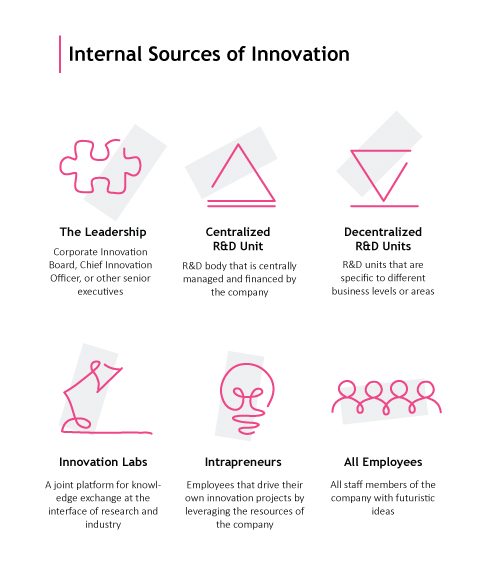Organizations often think that innovation comes from external breakthroughs or new technology. Sometimes, the most transformative ideas spring from within. We'll uncover six internal sources of innovation that every organization can tap into. Read on to discover the hidden power within your organization!

Summary and FAQs on Internal Sources of Innovation
What are internal sources of innovation?
Internal sources of innovation are idea and knowledge streams that originate within a company. They include leadership vision, R&D units, innovation labs, intrapreneurs, and employees. Unlike external sources, they rely on an organization’s own people, resources, and culture.
Why are internal sources of innovation important?
They help companies use their existing talent and knowledge to gain a competitive advantage. Internal innovation often leads to new products, services, or process improvements that are directly aligned with the company’s strategy and customer needs.
What are examples of internal innovation?
Examples include Toyota’s long-term investment in hybrid technology, Cisco’s global employee innovation challenge, and Lenovo’s intrapreneurship “Dream Lab.” These cases show how leadership, R&D, and employees can all be useful sources of innovation.
How do internal and external sources of innovation differ?
Internal sources rely on employees, managers, and in-house structures like R&D or labs. External sources involve customers, partners, suppliers, universities, or startups. Most organizations benefit from combining internal and external sources to create a balanced innovation strategy.
How can companies encourage internal sources of idea generation?
Firms can foster internal innovation by promoting a culture of experimentation, supporting intrapreneurs, and using software that support collaboration and idea management. Recognition programs, leadership support, and transparent evaluation systems can also motivate employees to contribute new product ideas and solutions.
1. Leadership as an internal source of innovation
Corporate Innovation Board, Chief Innovation Officer, or other senior executives
The strategy and the direction of innovation are set by a company’s top management. Yet, companies around the world are in the digital transition and face even larger leadership gaps. Today’s top management needs a completely different set of skills and expertise than in previous generations. Many organizations have not moved fast enough to develop digital leaders, provide a seat for decision-making to young leaders, and build new leadership models. Simply setting up an innovation department, and allocating money to it, does not create innovation. It is the management’s responsibility to make sure that innovation is grounded in the reality of the organization. The leadership should make sure to be a source for the overall drive, vision, and ambition of the organization with regard to innovation.
For example, the Chief Innovation Officer of Evonik Industries launched the global “Leading Innovation” initiative, which is aimed at managers and the company’s C-level. As a long-standing member of the management board, he knew first-hand that innovation at the board level had to become a more prominent topic. With this new initiative, Evonik managers now meet regularly to identify and manage innovation challenges, opportunities, and threats.
As the C-level executives set the direction for innovation, in a sense, they make the first step toward successful corporate innovation. The leadership’s attitude towards creating a safe space for innovation gives an incentive for employees to innovate. A good example is the case of Toyota, where the leadership encourages innovation by eliminating some of the pressure for short-run returns. Toyota’s decade-long investment in its brand Prius eventually resulted in creating a reputation for the company as a respected product innovator.
2. Centralized R&D units driving internal innovation
R&D body that is centrally managed and financed by the company
A central R&D body is an effective source for transformational innovation. Technology-intensive large corporations such as Microsoft and IBM actively conduct basic research internally in dedicated research centers. According to the 2014 “Proven Paths to Innovation Success’” study conducted by PwC’s strategy team, companies are intended to raise the portion of their R&D budget for innovation from around 40 percent up to 60 percent for the outlook of the next 10 years. This source of innovation is responsible for adjacent and transformational innovation, while incremental innovation is usually done by each business unit’s employees as part of their daily jobs.
Wacker Chemie AG, a German-based corporation and one of the most research-intensive chemical companies in the world, conducts R&D at two levels: centrally at its own Corporate Research & Development department and locally within different business divisions. The Corporate R&D unit coordinates activities on a company-wide basis and keeps all product and process innovations transparent in an overarching project management system. Wacker furthermore honors the work of its researches with different Group-wide R&D awards. The Alexander Wacker Innovation Award recognizes outstanding work in the areas of product innovation, process innovation, and basic research.
3. Decentralized R&D units
R&D units that are specific to different business levels or areas
Often large corporations that operate in multi-business scenes normally build for each business line a separate R&D body. As the innovation cycle and requirements for each business lines differ from each other, having a centralized R&D function does not make sense. In this case, each business line becomes a source of innovation. For example, in the consulting and financial services industry these within-unit R&D centers often foster different business lines that deal with market-specific regulations with a more individualized approach.
Due to differing customer needs across different markets, the French energy giant Schneider Electric created within-unit bodies for each line of business to manage its own R&D. The company tackles the digital transformation of energy management and automation across data centers and markets.
At Wacker Chemie, business divisions conduct application-driven R&D collaborating with customers, scientific institutions, and universities. The German corporation furthermore founded several Wacker Academy locations that provide a platform for sharing industry-specific knowledge between experts, customers, and partners.
4. Innovation labs for idea generation
A joint platform for knowledge exchange at the interface of research and industry
This innovation source fosters the company to build an independent body with full-time employees from different business units. Innovation labs can leverage the resources of the core business such as capital, technology, partnership, channels, or existing markets with strong leadership support. Among big corporations, there is a sudden rise in following the trend of creating innovation labs.
Companies as diverse as Delta Air Lines, Volkswagen, Marriott, Autodesk, Fidelity Investments, Vodafone, McKinsey, Wells Fargo, New York Times, Ikea, Cisco, Panasonic, Ford and Verizon accelerated the development of new innovation labs and initiatives with the hope to be prepared for what is coming next in global business disruption and transformation. Note that this source of innovation can be completely internal (only employees of the company are engaged) or mixed (both employees and external experts, startups collaborate).
Deutsche Bank has innovation labs in New York, Silicon Valley, London, and Berlin. The Deutsche Bank Labs link technology startups with the bank’s internal teams, allowing them to test products and solutions to meet their client’s needs. The labs assess and implement emerging technologies and support the digital strategy of the bank.
Also see: Podcast episode with Hans Lind from Volvo Group on "How to Make Innovation Labs Work"
5. Intrapreneurs as innovation drivers
Employees that drive their own innovation projects by leveraging the resources of the company
Another source that triggers innovation in large corporations is intrapreneurship. The latter is a relatively recent concept and refers to the case when an employee has entrepreneurial acumen and starts his/her own innovation project inside the company.
At Intuit, when an employee comes up with a product or business idea, the necessary resources are provided to create a prototype to test the hypothesis with just one customer who is a potential user of that product. If the customer likes the product and recommends it to others, then more prototypes are produced for a larger cohort of customers in order to collect more data.
In 2015, Lenovo started an intrapreneurship project named “the Dream Lab” to help business-driven employees in their startup projects. A jury of Lenovo executives and external investors chooses the most promising ideas during a roadshow, then the winning projects are awarded a four-month acceleration service by the Dream Lab. Successful projects are later either becoming part of Lenovo’s core business or functioning as independent ventures.
6. All employees as a source of ideas
All staff members of the company with futuristic ideas
Companies are making innovation everyone’s job, even if they invest in creating R&D centers and innovation labs. For many firms, the innovation agenda is now as much about human capital investment as delivering new products and services. Innovation has become an integral part of the interview and onboarding processes. Job candidates are often asked to offer innovation-oriented business concepts that produce growth.
A company’s employees together make up one of the biggest sources of new idea generation. Due to experience and knowledge within an industry and its related products, employees are often the most informed innovation source and can deliver thorough, insightful proposals for new products and services. Employees need to be encouraged to submit their proposals. Lack of proper technology and upward communication limit employees from making their voices heard. Specialized software for idea management helps to collect, evaluate, and select ideas collaboratively.
Cisco ran a company-wide Innovate Everywhere Challenge aiming to capture disruptive venture ideas from its employees. After the first pilot round, Cisco started the second and the third challenge aiming to integrate the ideation challenge as part of its innovation management. As a result, 53% of all employees in 89 countries participated, nearly 800 ventures were submitted by about 1,600 employees, 62% of the participants formed teams, and 20 executives are sponsoring ventures with seed funds. The challenge was a great success and boosted disruptive thinking across all business units, functions, geographies, and grade levels.
The role of software in harnessing internal sources of innovation
In the digital era, software is no longer just a tool—it's an active participant in shaping innovation. Whether it's through facilitating collaboration, managing workflows, or analyzing vast amounts of data, software solutions are crucial in harnessing the full potential of internal sources of innovation.
The ITONICS Innovation OS is an end-to-end innovation management solution designed to systemize all activities from strategy to execution, at scale. It offers a variety of tools and features for different use cases that help companies ensure a seamless transition from conceptualizing ideas to implementing them, fostering a culture where internal sources of ideas and concepts are not just recognized but systematically integrated into every facet of the business.
1. Software as a collaboration catalyst
One of the most significant barriers to innovation is the lack of effective communication and collaboration within organizations. With remote working becoming more prevalent, software solutions like ITONICS allow for seamless collaboration are proving invaluable. Such platforms ensure that all team members, regardless of their location, can share insights and ideas, provide feedback, and jointly work on projects, making sure that no innovative idea falls through the cracks.
2. Data analysis and insights
Companies are inundated with data. From customer preferences to operational metrics, the sheer volume of information can be overwhelming. However, this data, when appropriately analyzed, can be a goldmine for innovation. The ITONICS Innovation OS allows organizations to visualize data, derive actionable insights, and recognize patterns that might indicate potential avenues for innovation.
3. Workflow management and efficiency
Efficient workflow is the backbone of any innovative company. ITONICS helps teams stay on track, prioritize tasks, and ensure that innovative projects move forward without unnecessary delays.
You want to learn more about the features and functionalities of the ITONICS Innovation OS to streamline your innovation activities? Book a demo with our experts today!




